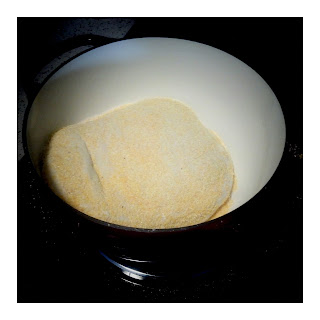 |
| Bottom, starting in the front: Sea Salt (coarse grain hollow pyramids), Ground Nutmeg, Sumac Berries, Smoked Spanish Paprika, Aleppo Pepper, Indonesian Cinnamon (Korintje) |
One of the most interesting-shaped food accessories I use, although not often, is coarse grain sea salt. The delicate crystals are scooped from the surface of the brine and allowed to dry by wind and sun - creating a miniature hollow pyramid shaped crystal. The coarse salt is fantastic on fresh heirloom tomatoes drizzled with olive oil but maybe next time I'll try it mixed with an herb butter on warm bread.
Nutmeg is a great spice to keep around because it works in both sweet and savory dishes. I'm a firm believer that nutmeg works with any meat: ground beef, shredded chicken, pork chop, lamb kebob...yes everything. Take your nutmeg beyond the pumpkin pie - perhaps to eggnog land or latte town. Potato salad, scrambled eggs, sweet potato muffins, hot cider.
Turkish ground sumac berries were new to me until I found a spice store that allowed me to smell the herbs and spices before buying. Smelling food helps me think about how to use it. Ground sumac is often sprinkled on top of hummus (although paprika works too) along with a olive oil. It is fruity and sour and works well when you'd use lemon in a dish by brightening the flavors and adding that sour note to something already salty/sweet/bitter.
My love of Spanish paprika is in need of censoring. Smoky, peppery, bitter, sweet. Great mixed with salt, black pepper and olive oil and rubbed on vegetables before roasting or sprinkled on top of a creamy potato or squash soup. Eggs, chicken, salad dressing....
Aleppo pepper is another spice I'd never used before I had the chance to smell it but right after bringing it home I read that it was the number one underused/favorite spice of 2011. Okay. Good, I'm all about being trendy. It's got a little heat that definitely builds in dishes that sit overnight. It dresses up my favorite thin crust pizza (Whole Foods, no really) and works well with strong meaty dishes.
And finally cinnamon. Not just any cinnamon, because there are different kinds and when you find this out it will blow your mind, maybe, just a little. Indonesian cinnamon or korintje is strong, warm, spicy, sweet and delicious. I've put it in every baked good for the past year - chocolate muffins, banana bread, carrot cake, oatmeal cookies and would never have oatmeal without it. In fact, I should take it with me when I travel, that won't be suspicious at all!



















